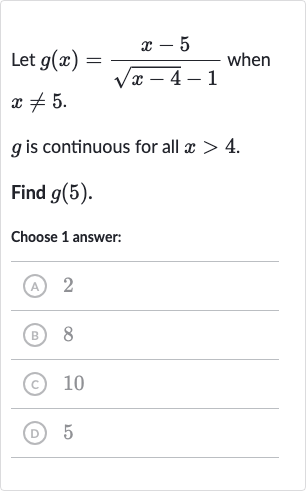Full solution
Q. Let when . is continuous for all .Find .Choose answer:(A) (B) (C) (D)
- Define Limit of : To find the value of , we need to evaluate the limit of as approaches , because is not defined at but is continuous for all x > 4. This suggests that we should use the limit process to find .
- Simplify Expression by Conjugate: We can simplify the expression for by multiplying the numerator and denominator by the conjugate of the denominator to eliminate the square root in the denominator. The conjugate of is .
- Multiply Numerator and Denominator: Multiplying the numerator and denominator by the conjugate, we get:g(x) =
- Simplify Denominator: Simplifying the denominator using the difference of squares, we get:
- Further Simplify Denominator: Further simplifying the denominator, we get:
- Cancel Out Common Term: We can now cancel out the term in the numerator and denominator, as long as is not equal to . This is valid because we are interested in the limit as approaches , not the value at .
- Final Simplified Expression: After canceling out the term, we are left with:g
- Substitute : Now we can safely substitute into the simplified expression to find :
- Calculate Final Value: Calculating the square root and adding , we get:g = + = + =

